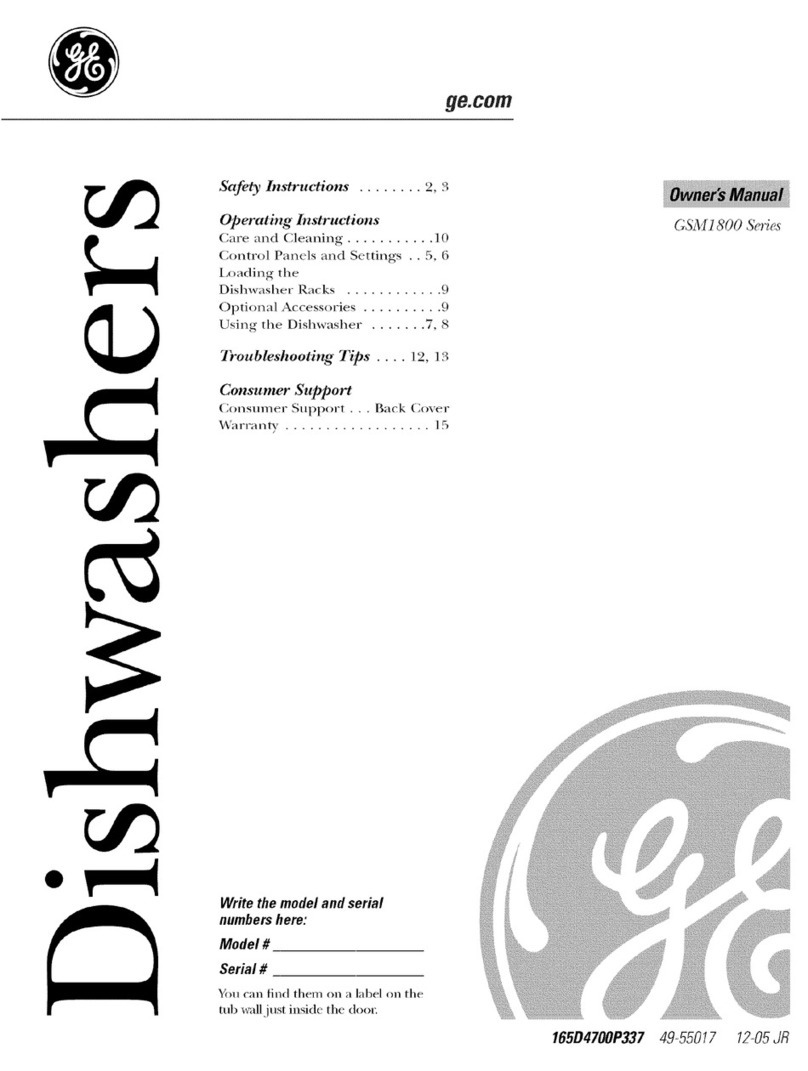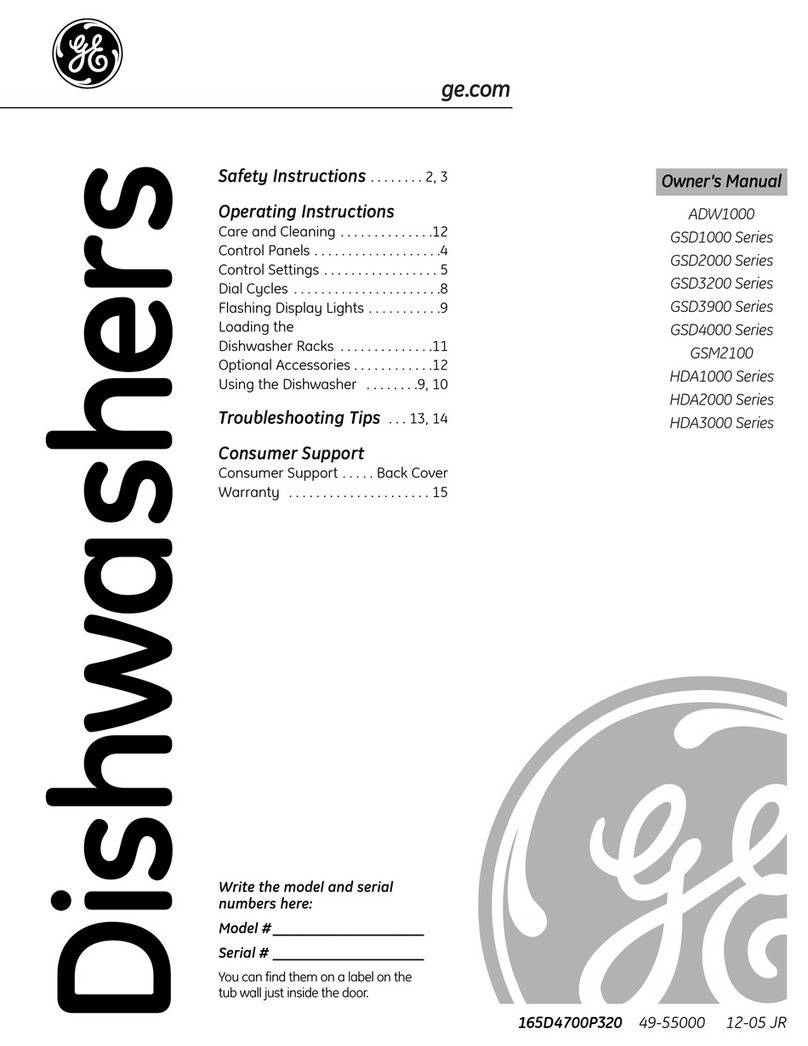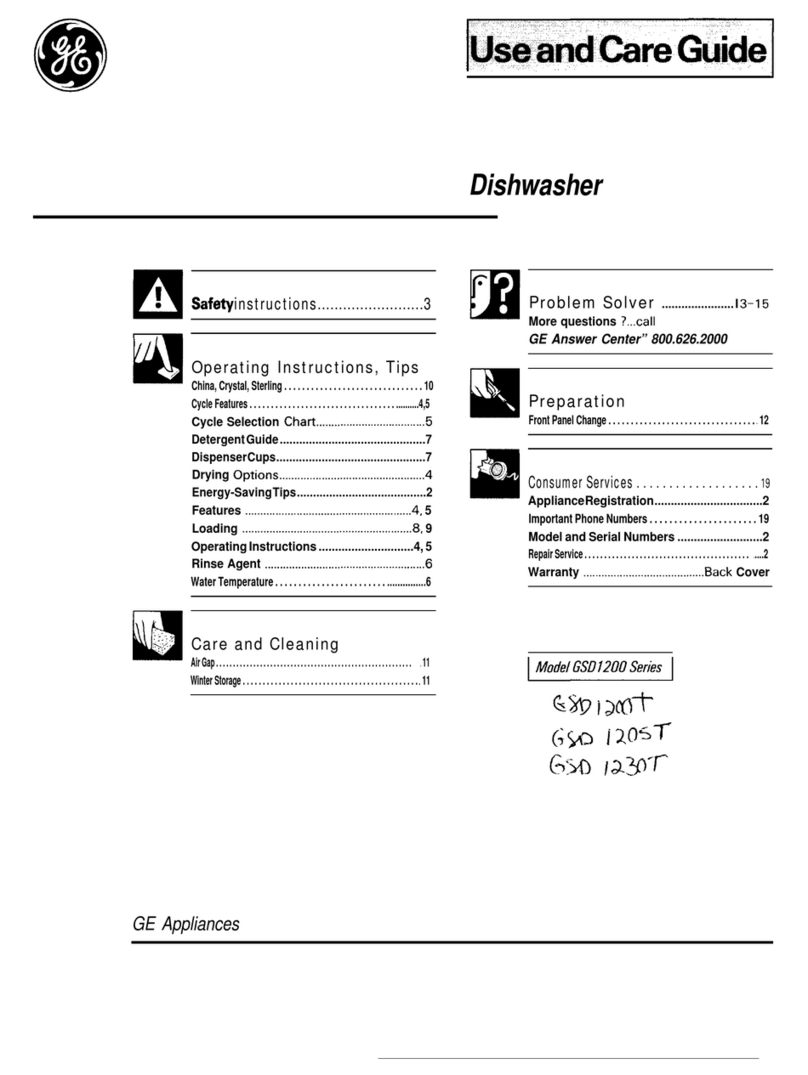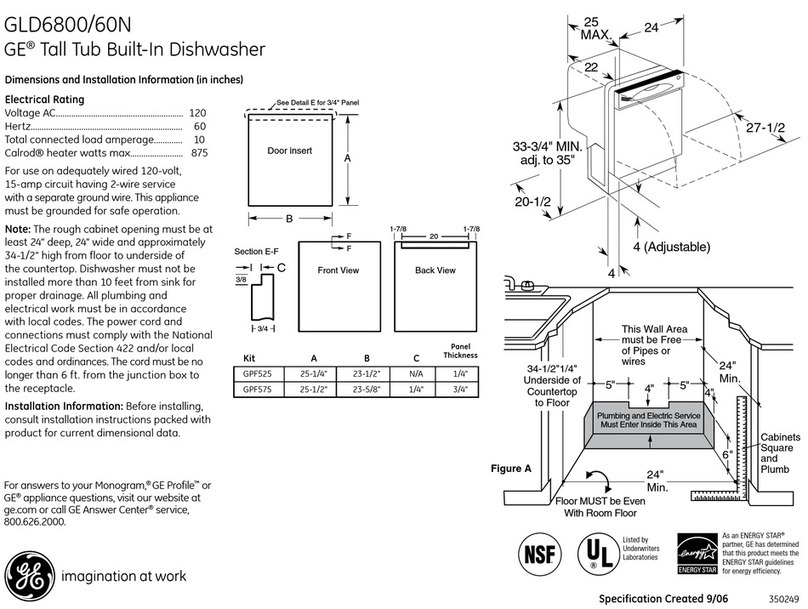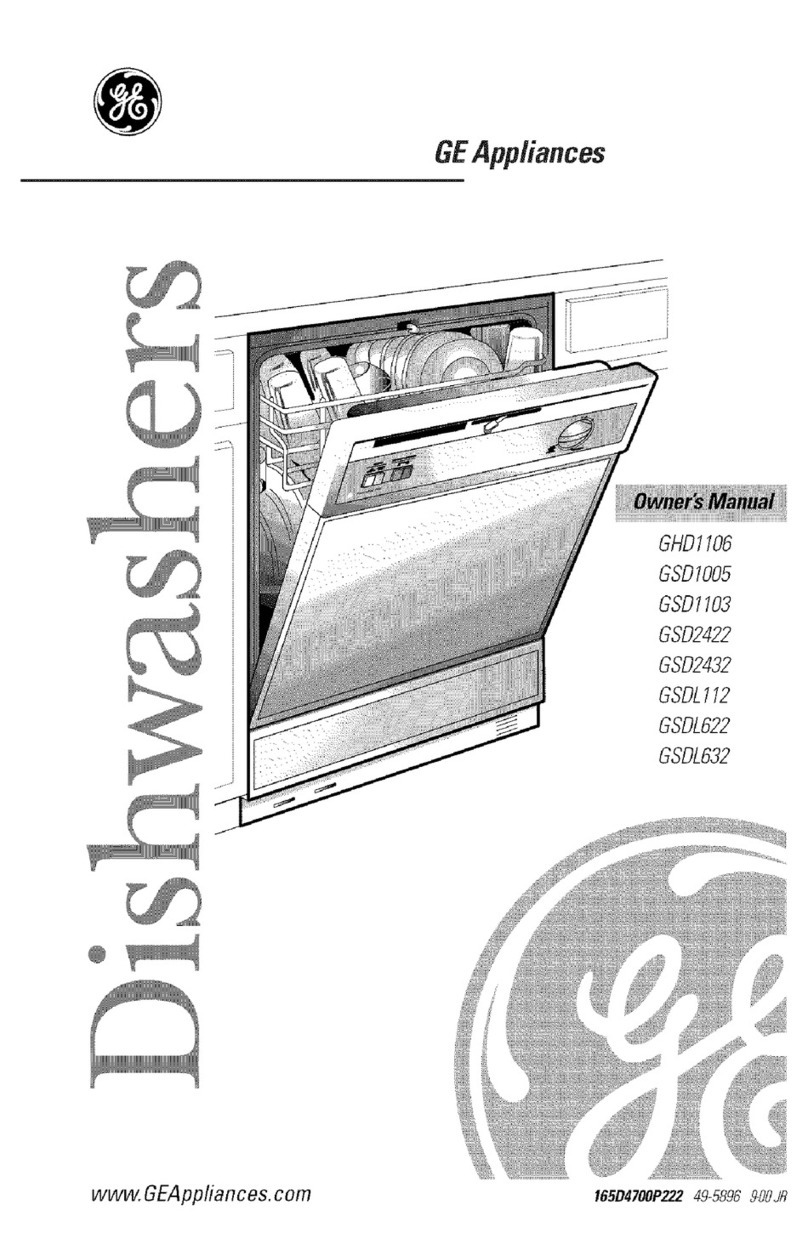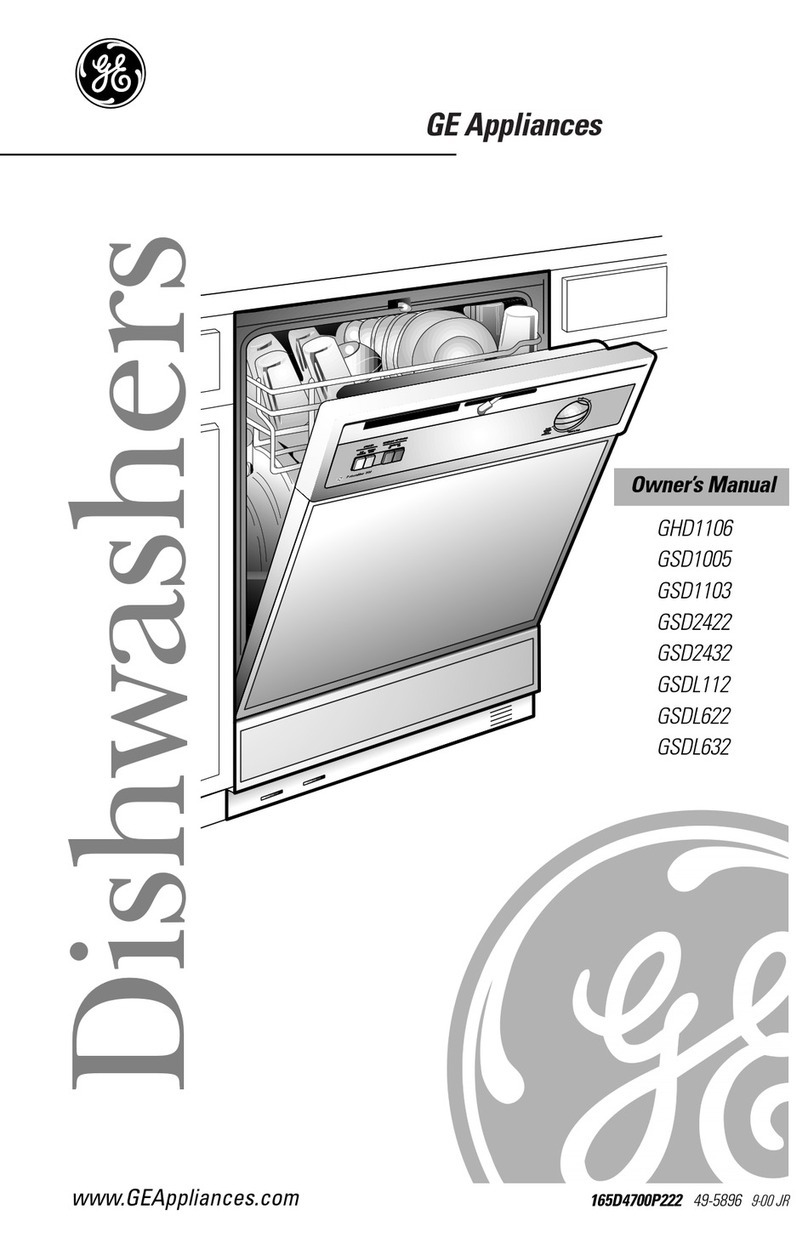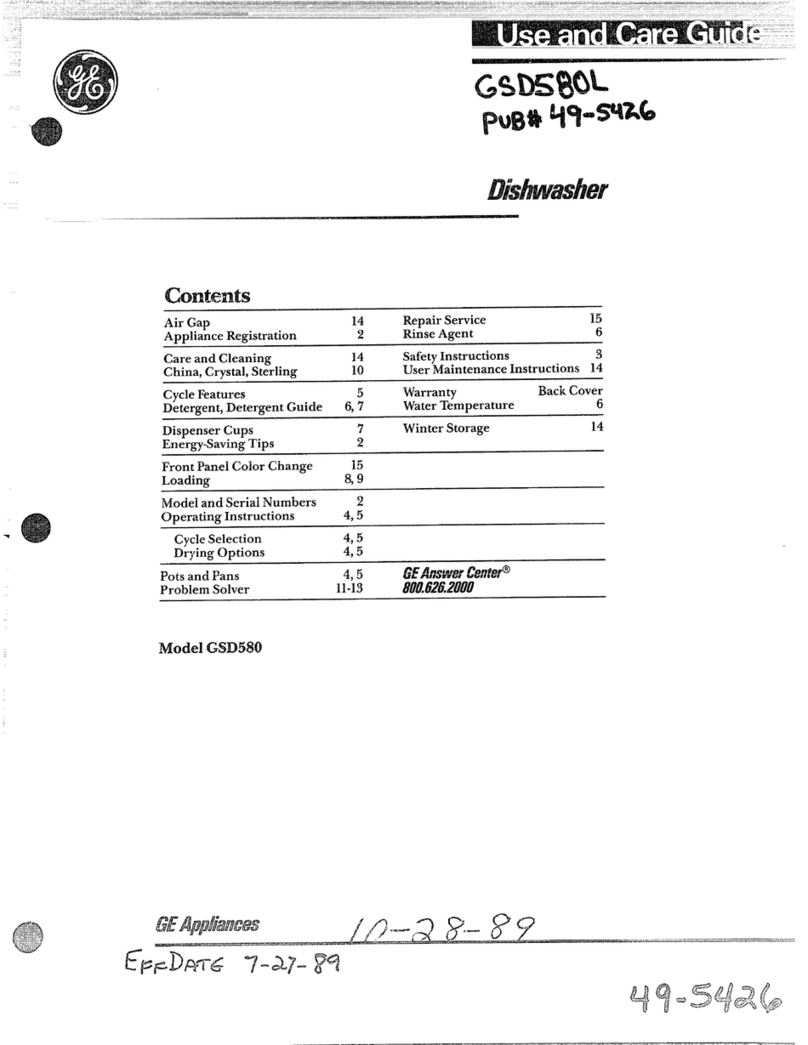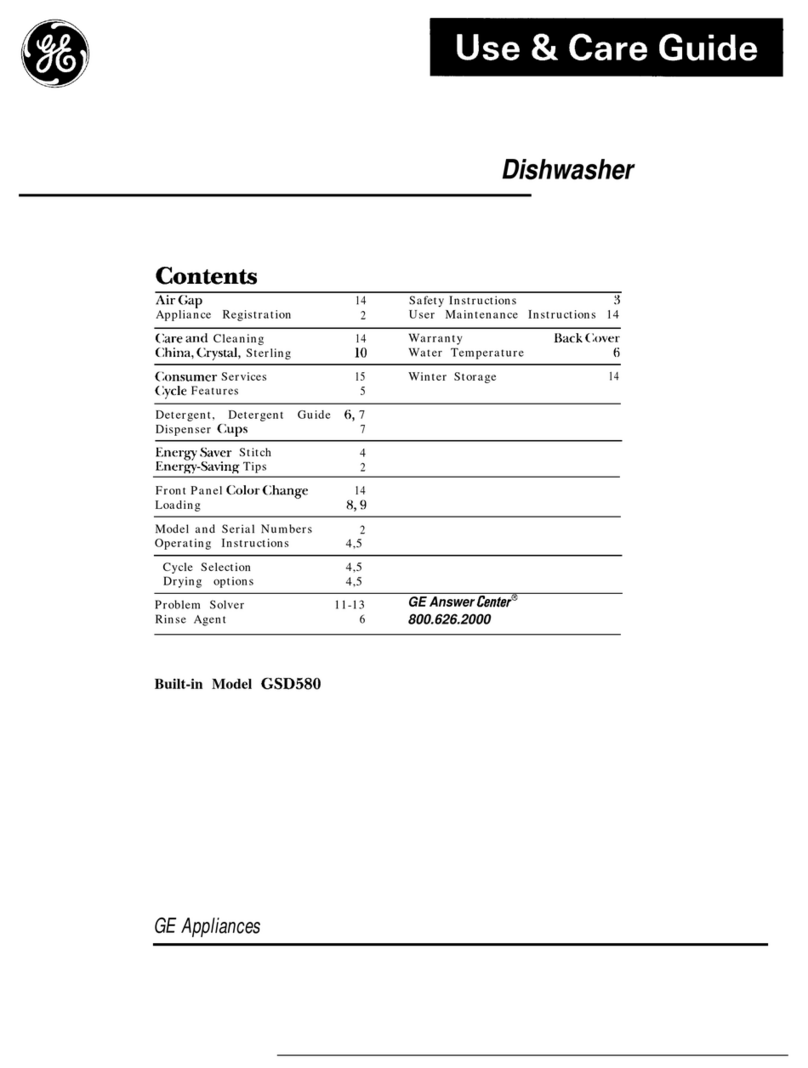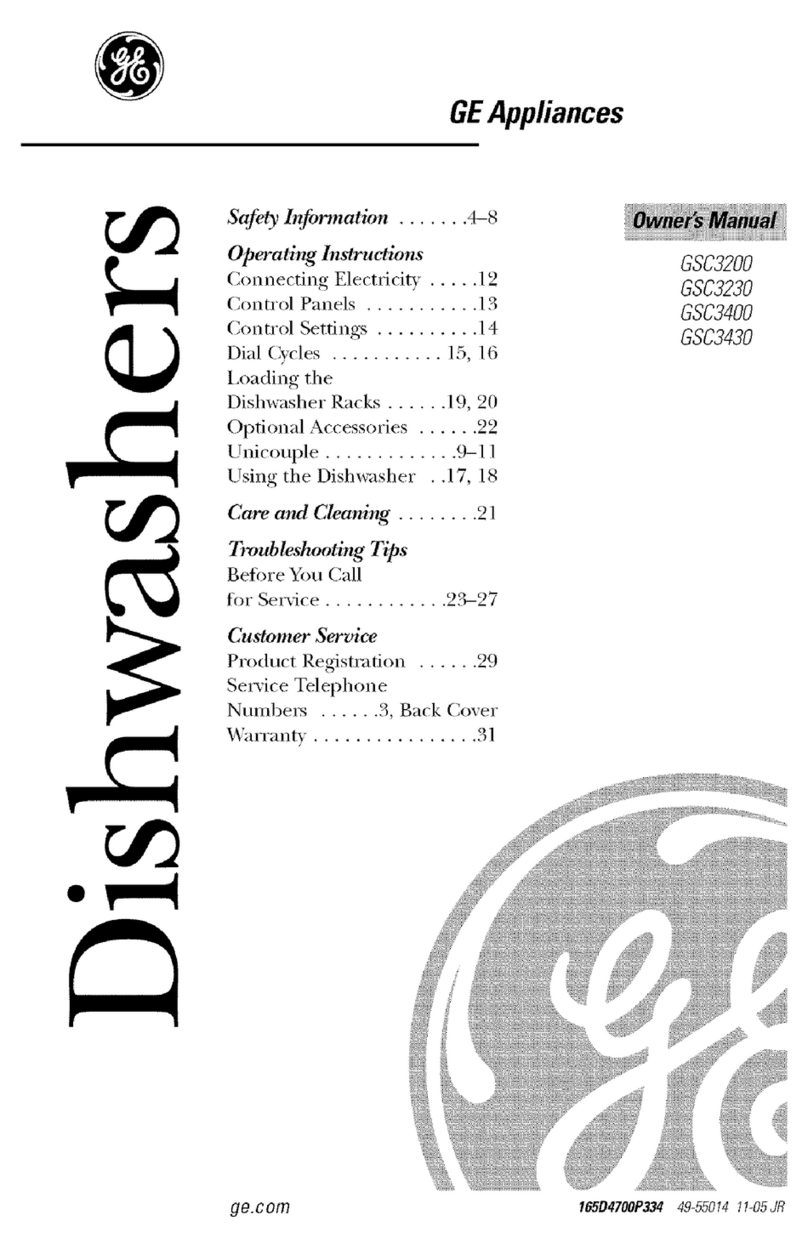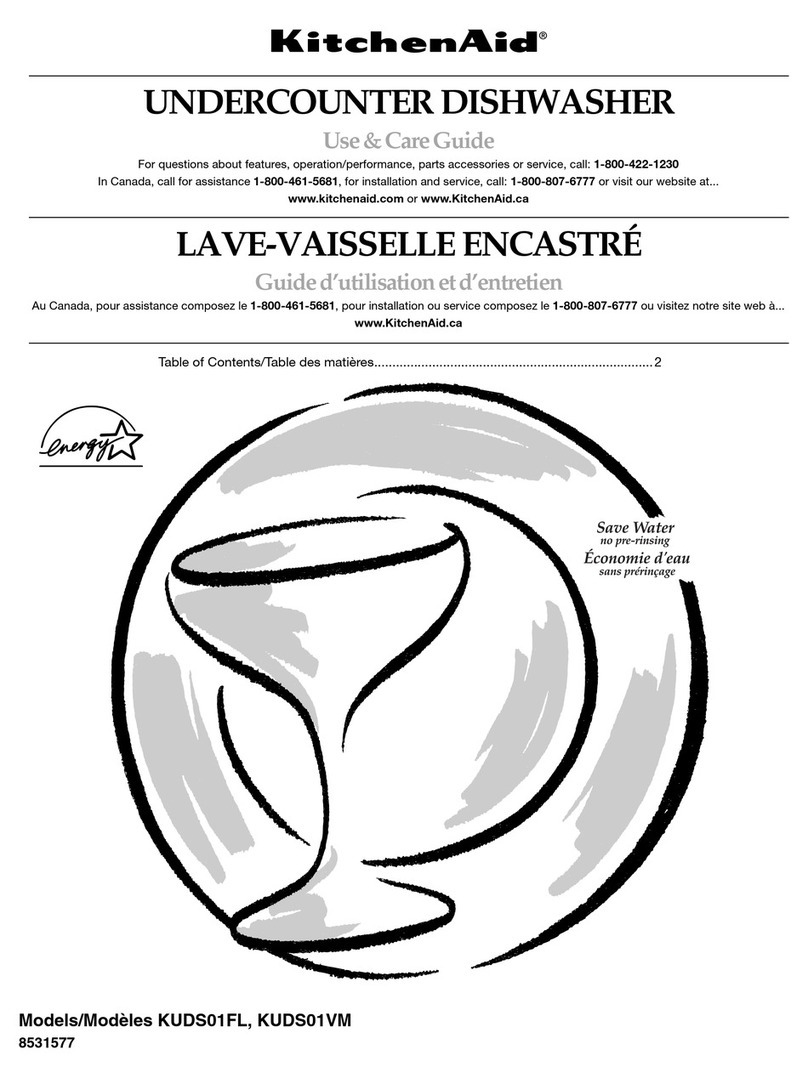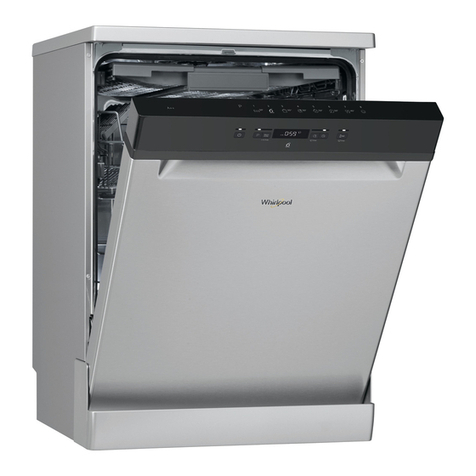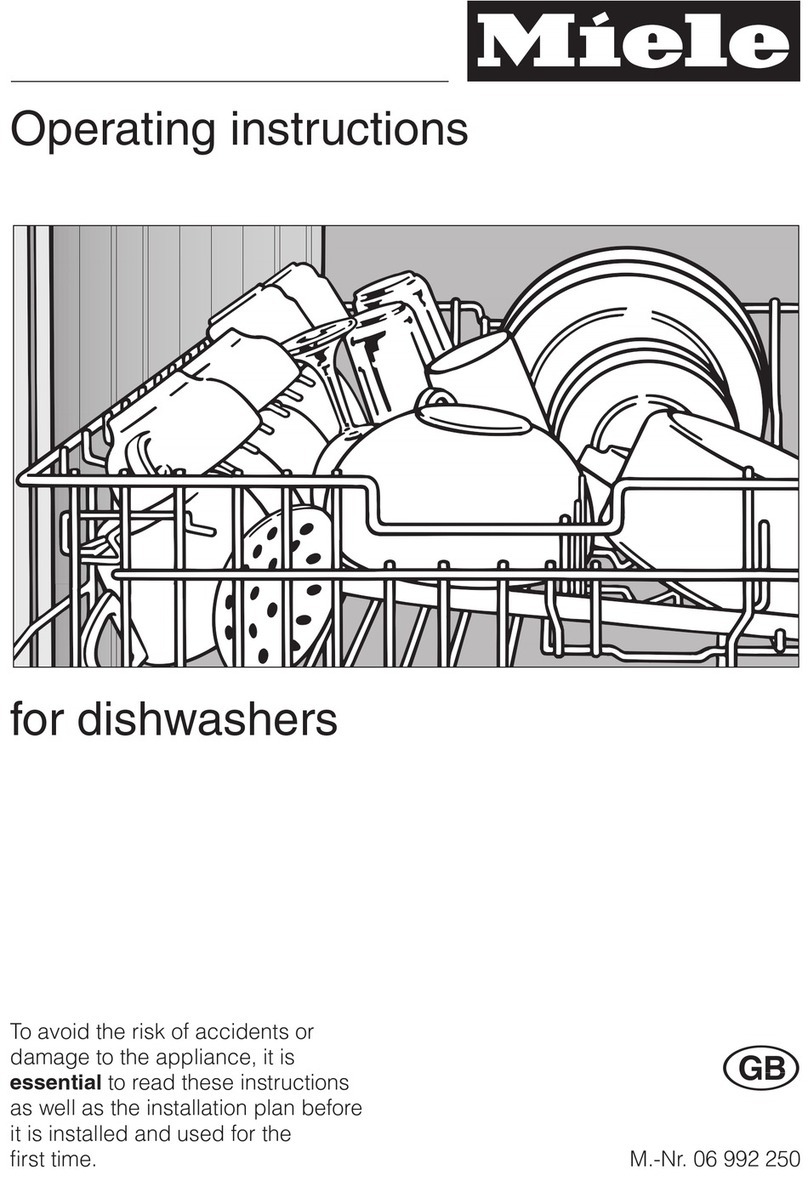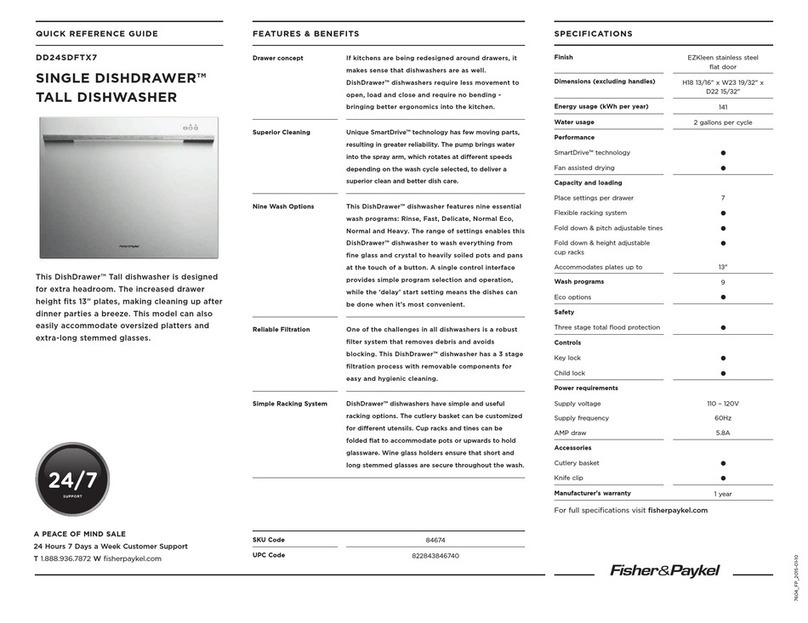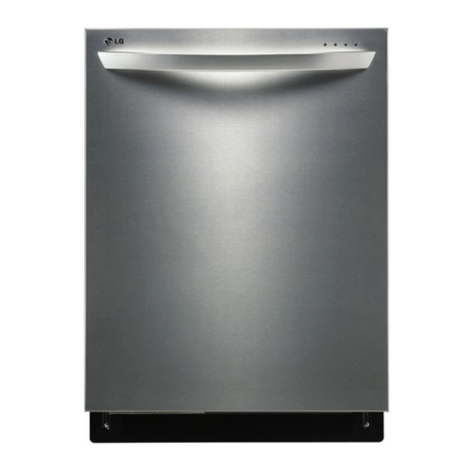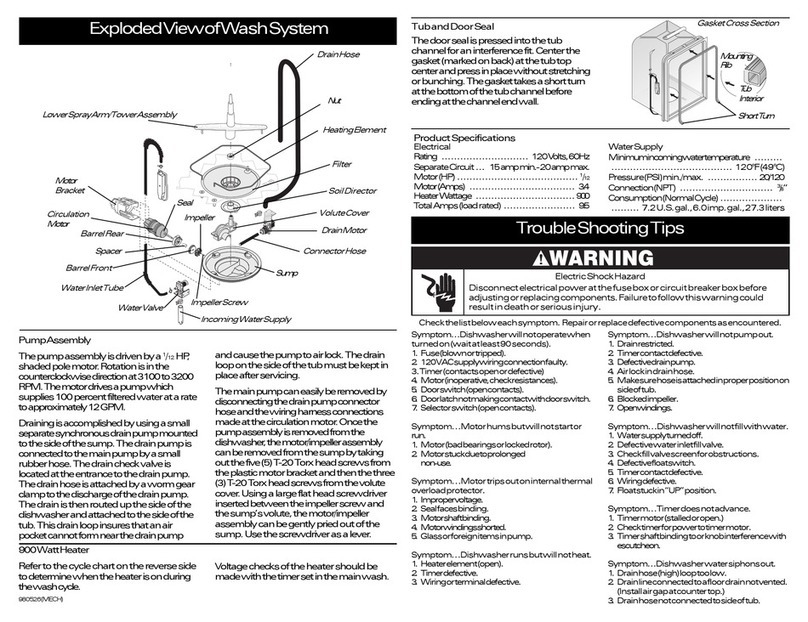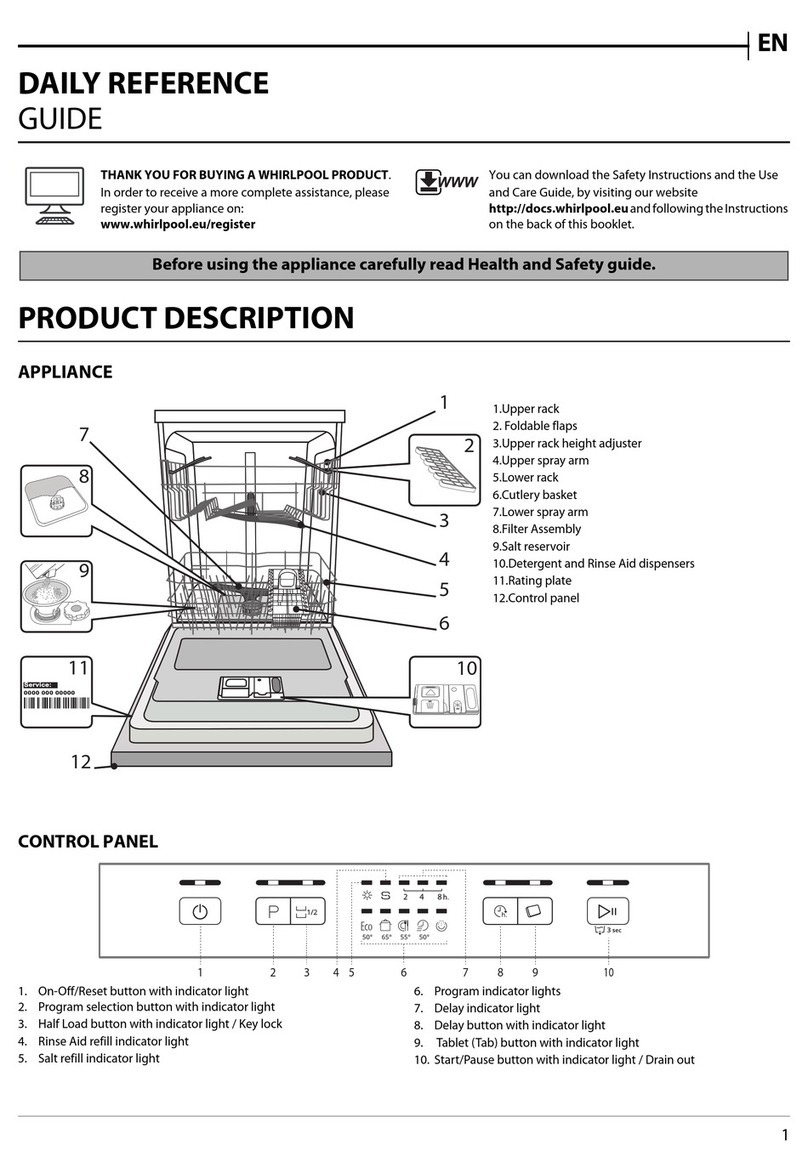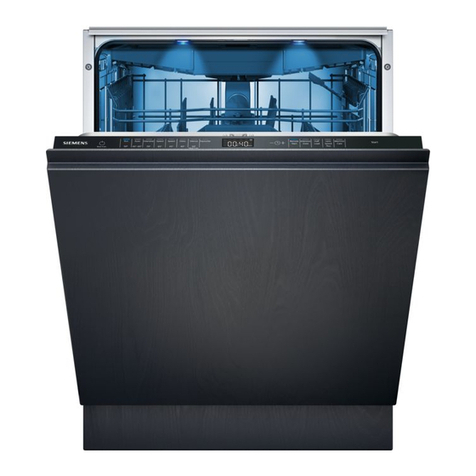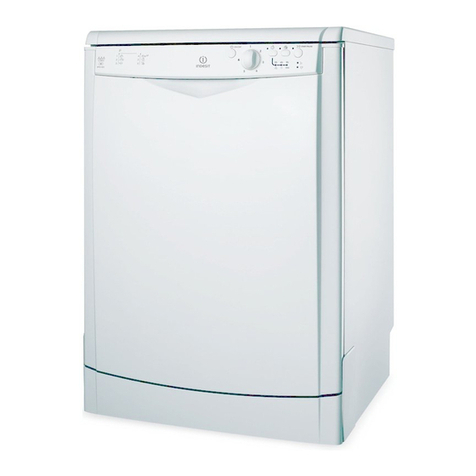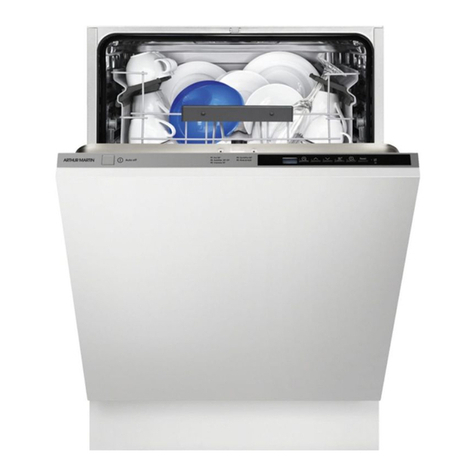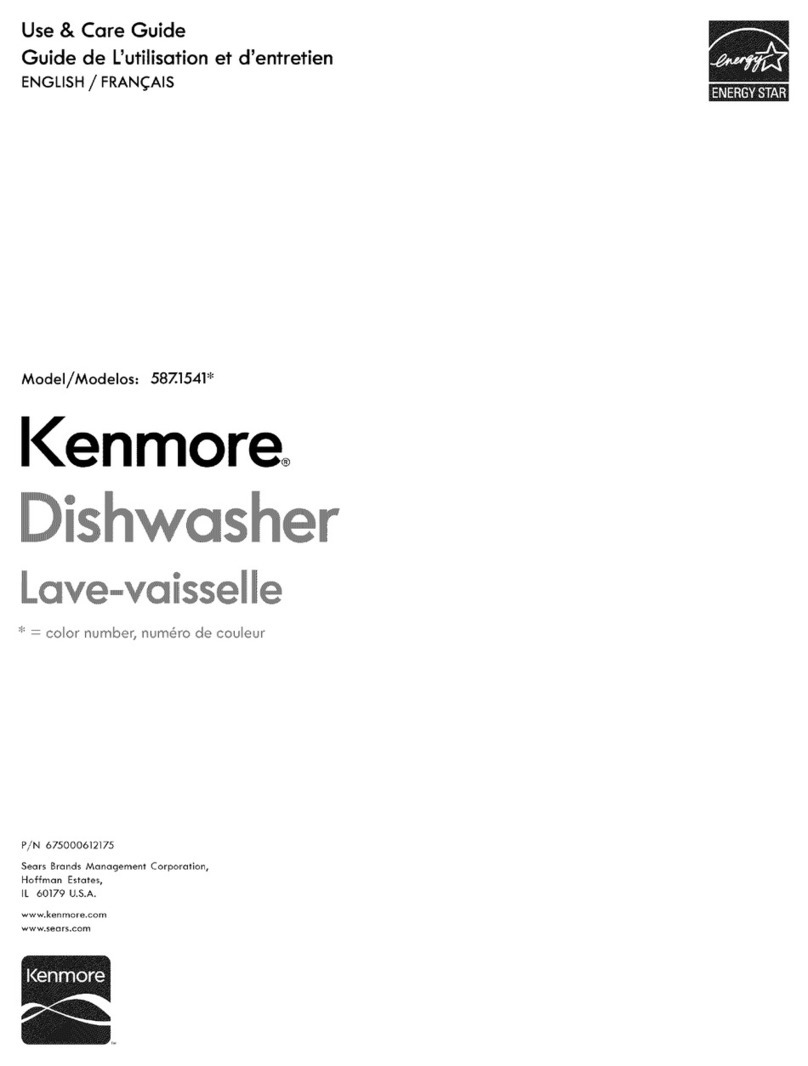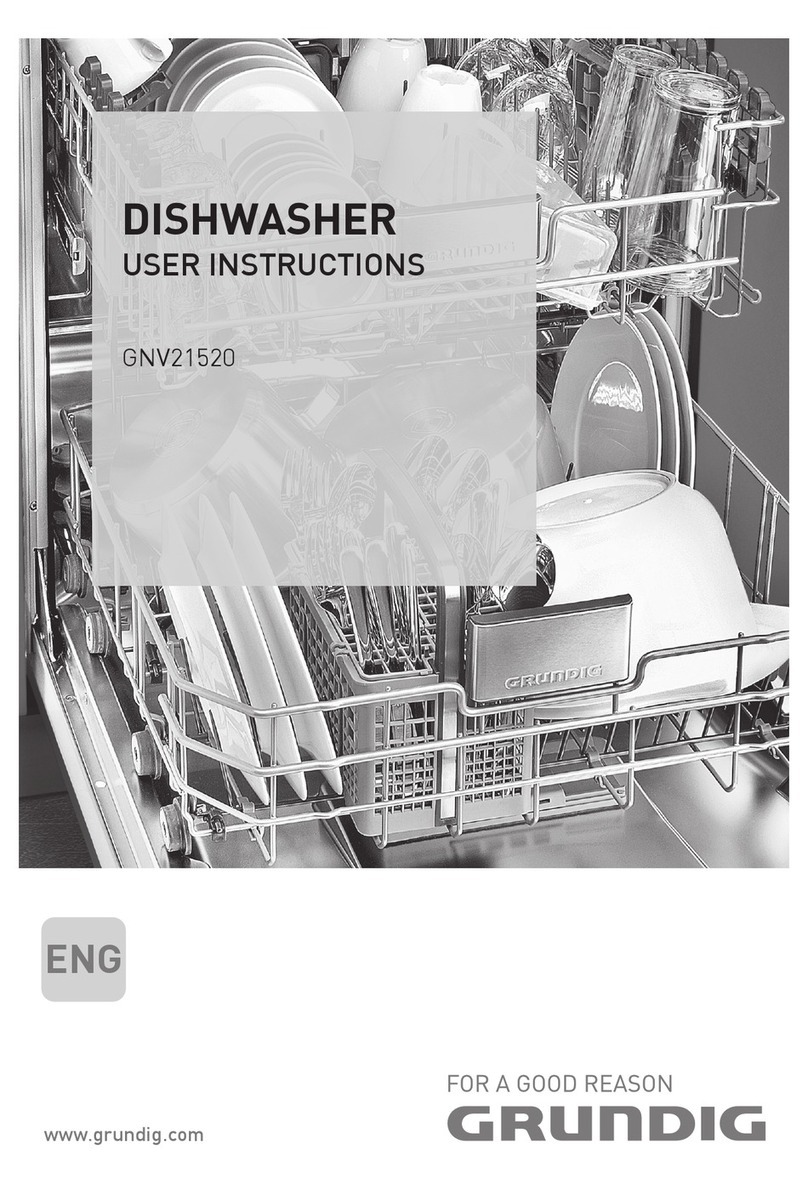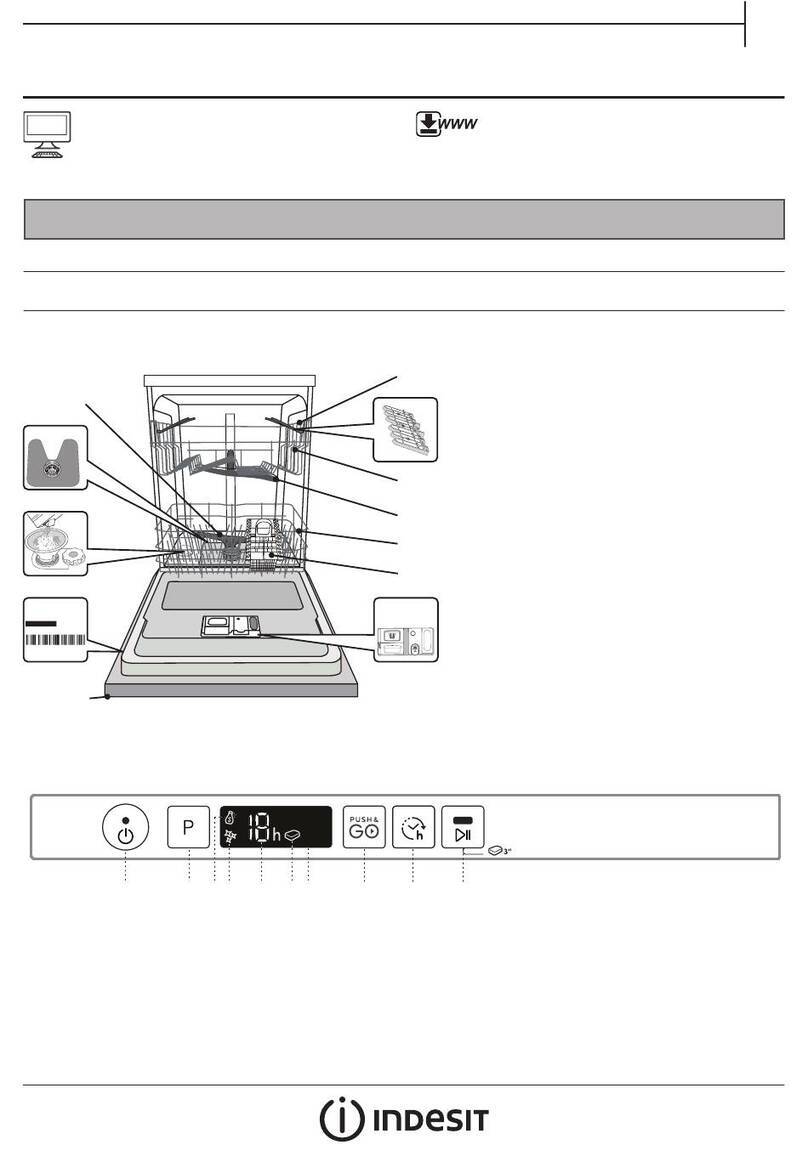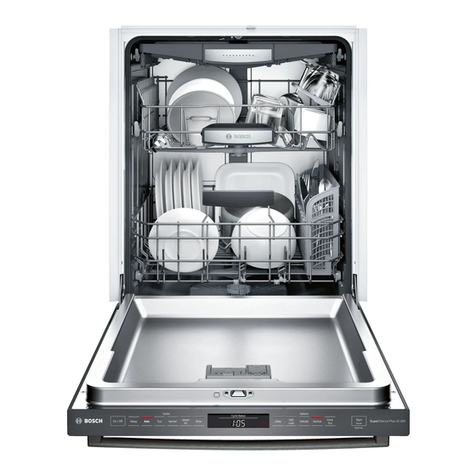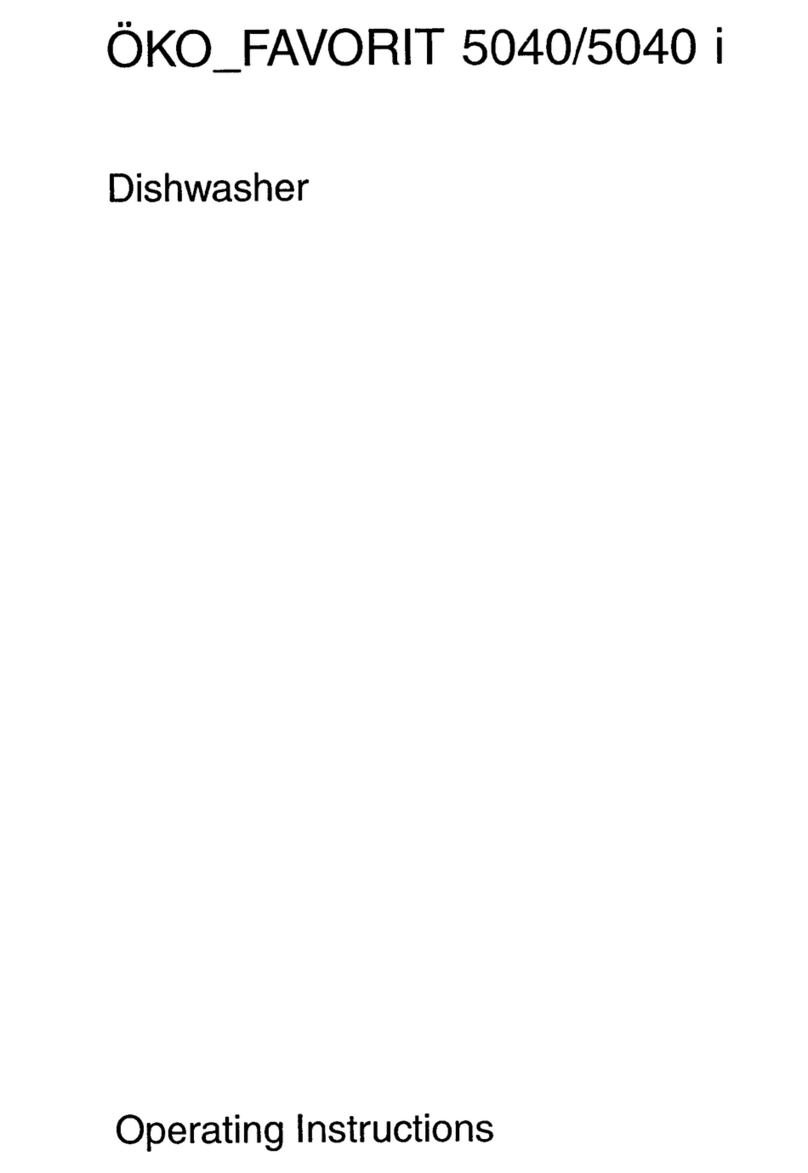GE PDW1860KSS User manual

10 49-55105
Getting started
USING THE DISHWASHER
Load Dishwasher
For best dishwashing results, follow the loading guidelines found in the Loading section. Scrape off hard soils, including
bones, toothpicks, skins, and seeds. Remove leafy vegetables, meat trimmings, and excessive amounts of grease or oil.
Add Detergent
Add needed amount of detergent to the detergent dispenser. Use detergent such as
Cascade®Platinum ActionPacs™
. See
Dispensers section.
Add Rinse Agent
Add rinse agent such as Cascade
®
Platinum Rinse Aid™to the rinse agent dispenser. See Dispensers section.
Select Cycle
Open the door and press the Select button for the desired wash cycle. The LED below the cycle name will be lit to indicate
ZKLFKZDVKF\FOHKDVEHHQVHOHFWHG3UHVVWKHEXWWRQXQWLOWKHGHVLUHGF\FOHLVVKRZQ
HEAVY This cycle is meant for heavily soiled dishes or cookware with dried-on or baked-on soils. This
cycle may not remove burned-on foods. Everyday dishes are safe to be used in this cycle.
NORMAL This cycle is for medium to heavily soiled dishes and glassware. This cycle includes heated dry.
NOTE: NORMAL was used to rate the energy efficiency of this dishwasher.
LIGHT
This cycle is for lightly soiled dishes and glassware. Cycle includes heated dry.
GLASSES
This cycle is for lightly soiled glassware. This cycle has a lower temperature heated dry.
AIR-DRY
This cycle is for loads of everyday dishes, glasses and cookware with light soils that have been
pre-rinsed and should dry naturally. This cycle does not include heated dry.
SPEED
This cycle is for loads of everyday dishes, glasses and cookware with medium soils. This cycle features
reduced wash times to allow for faster cycle completion. This cycle also has reduced heated dry.
RINSE This cycle is for rinsing partial loads that will be washed later. This cycle does not include heated
dry. DO NOT use detergent with this cycle.
Select Option
DELAY
HOURS This option allows you to delay the start of a wash cycle for up to 24 hours.
With the door open and a cycle selected, press the DELAY HOURS button to choose the number
of hours you want to delay the wash cycle. The hours will show in the display window.
NOTE: To cancel the DELAY HOURS option before the start of the cycle, repeatedly press the
DELAY HOURS button until the display reads “00.”.
Start Dishwasher
START/
RESET 3UHVVWKHSTART/RESET button and close the door within 4 seconds to start the cycle or begin the
DELAY HOURS start countdown. The START/RESET LED will light. The wash cycle will begin after
10 seconds and then pump out for 60 seconds prior to filling the dishwasher with water. To activate
the display, press any button with the door open.
Interrupt
or Pause To interrupt or pause a dish cycle, slowly open the door. Opening the door will cause the wash cycle
to pause. The dishwasher will beep every minute to remind you to close the door. To restart or resume
the cycle, press START/RESET, and close the door within 4 seconds. If the door is not closed within
4 seconds, the START/RESET LED will start blinking and the dishwasher will beep once every minute
to signal that the cycle did not restart. If the the START/RESET LED is blinking, the dishwasher is
waiting for input.
Cancel To cancel a wash cycle, press and hold the START/RESET button for 3 seconds with the door open,
and then close the door. This dishwasher will drain and the wash cycle lights will turn off.
Indicator Lights
CLEAN The green light will display and a beep will sound to alert you that the wash cycle is complete. If
the door is NOT opened, the beep will sound four times.
LOW
RINSE AID On some models, indicator would be displayed when rinse agent is low or empty. See
Dispensers section.
Display
Time
Remaining During operation, the display shows the total number of minutes remaining in the cycle (up to 99
minutes). For cycle times above 99 minutes the display will read “99”. During a delay start, the
display will show hours of time remaining until the cycle starts.
1
2
3
4
START
RESET
DELAY
HOURS
CYCLE
SELECT
1 - 24 HR.
LOW RINSE AID
HEAVY NORMAL
LIGHT GLASSES AIR-DRY SPEED RINSE
CLEAN
5
6
7
8

49-55105 11
USING THE DISHWASHER
Loading
Upper Rack
The upper rack is for glasses, cups and saucers. This
is also a secure place for dishwasher-safe plastics. A
cup shelf may be placed in the up or down position to
add flexibility. The upper rack is good for all kinds of
odd-shaped utensils. Saucepans, mixing bowls and other
items should be placed face down.
Secure larger dishwasher-safe plastics over 2 tines when
possible.
Make sure small plastic items are secure so they can’t
fall onto the heater.
Be sure that items do not protrude through the bottom of
the rack and block rotation of the middle spray arm. This
could result in poor wash performance for items in the
upper rack.
Lower Rack
When loading the lower rack, do not load large platters
or trays in the front left corner. They may prevent
detergent from circulating during the wash cycle.
The lower rack is best used for plates, saucers and
cookware. Large items should go along the sides. Load
platters, pots and bowls along the sides, in corners or in
the back. The soiled side of items should face the center
of the rack.
Also, be careful not to let a portion of an item such as
a pot or dish handle extend through the bottom rack.
This could block the wash arm and cause poor washing
results.
Silverware Basket
The silverware basket may be used without the topper
for quick loading. With the topper, flatware is better
positioned for the dishwasher to thoroughly wash and dry
all pieces by preventing nesting.
Without the topper
3XWWKHIODWZDUHLQWKHUHPRYDEOHEDVNHWZLWKIRUNDQG
NQLIHKDQGOHVXSWRSURWHFW\RXUKDQGV3ODFHVSRRQV
in the basket with handles down. Mix knives, forks and
spoons so they don’t nest together. Distribute evenly.
Small plastic items, such as measuring spoons and lids
from small containers, should go in the bottom of the
silverware basket with silverware on top.
With the topper
3ODFHVPDOOSODVWLFLWHPVVXFKDVPHDVXULQJVSRRQVDQG
lids from small containers, in the bottom of the basket
and snap the topper in place. Insert spoons and forks,
KDQGOHVILUVWWKURXJKWKHKROHVLQWKHWRSSHU3ODFH
knives, blades first, through the holes in the topper.
For best dishwashing results, follow these loading guidelines.
Don’t let any
item extend
through
bottom.

12 49-55105
USING THE DISHWASHER
Check the Water Temperature
The entering water should be at least 120°F (49°C) and
not more than 150°F (66°C) for effective cleaning and to
prevent dish damage. Check the water temperature with a
candy or meat thermometer.
Turn on the hot water faucet nearest the dishwasher,
place the thermometer in a glass and let the water run
continuously into the glass until the temperature stops
rising.
Dispensers
Use a Rinse Agent
Rinse agents, such as Cascade®Platinum Rinse Aid™are designed for great drying action and to protect against
spots and film build-up on your dishes, glasses, flatware, cookware, and plastic.
Filling the Rinse Agent Dispenser
The rinse agent dispenser holds 3.5 oz. (104 ml) of rinse agent. Under normal conditions, this will last approximately
one month.
1Make sure the dishwasher door is fully open.
2Turn the dispenser cap counterclockwise and lift out.
3Slowly add rinse agent until the cup is full. You may need to pause several times to allow
rinse aid to settle.
4Clean up any spilled rinse agent with a damp cloth to prevent foam from forming inside
the dishwasher.
5
Replace the dispenser cap.
Rinse Aid Setting
The amount of rinse agent released into the final wash can be adjusted.
The factory setting is at the midpoint. If water drops or hard water spots
remain on dishes after the dry cycle,
increase the setting.
To adjust the setting
Remove the dispenser cap;
Turn the adjuster counterclockwise
to increase the amount of rinse agent,
clockwise to reduce the amount of rinse
agent.
M
i
n
M
a
x
Indicator
Dispenser cap
Adjustable setting dial
M
i
n
M
a
x
M
i
n
M
a
x
Counterclockwise
to reduce water
drops and hard
water spots
Clockwise to
reduce foaming

49-55105 13
Dispensers
USING THE DISHWASHER
Detergent Dispenser
The detergent dispenser has two compartments. To
open, press the button and the cover will flip back. The
pre-wash compartment is on the lid of the detergent
dispenser. Use the pre-wash compartment only when
your water is extremely hard or when you have a heavy
soiled load. The pre-wash compartment is not used
when tablet or packet detergents are used.
You may use tablet, packet, powder, liquid or gel automatic
dishwasher detergent. Make sure you use only detergents
specifically labeled for use in automatic dishwashers. Never
use liquid hand dish detergent in an automatic dishwasher.
Sudsing and poor wash performance will result with the use
of improper detergents.
Detergents should be stored in a dry location and in their
RULJLQDOFRQWDLQHUWRSUHYHQWORVVRIHIIHFWLYHQHVV3ODFH
detergent in the cup just prior to starting the dishwasher
and then close the cover. The cover will open during the
wash cycle.
Filling the Detergent Dispenser
GE Appliances recommends using detergent in tablet or
packet form. Independent testing has shown this form of
detergent is very effective in the dishwasher. Cascade®
Platinum ActionPacs™are an example of this type of
detergent. Simply put a tablet or packet into the main
wash compartment and close the detergent cup cover.
3OHDVHQRWLFHWKDWWKHWDEOHWRUSDFNHWPXVWEHSODFHG
in the main wash compartment of the detergent cup.
If the tablet or packet is tossed in the bottom of the
dishwasher, the detergent will be flushed down the drain
in a very short period of time and will thus be wasted.
Wash performance will be very poor as a result.
If you choose to use detergent in powder, liquid or gel
form, the amount of detergent you use will be determined
by the hardness of your water, the temperature of your
water, and the food soil load inside the dishwasher.
Contact your water company to get information about the
hardness of the water in your area. Water hardness is
measured in grains per gallon. Use this information and
the table above to determine the amount of detergent
to use. You may purchase a hard water test strip from
GE Appliances. Call 1-877-959-8688 and ask for part
number WD01X10295. In Canada, call 1-800-661-1616.
Using too much detergent with very soft and/or very
hot water may cause a condition called etching on your
glassware. Etching is a permanent cloudiness in your
glassware. This condition is irreversible. However, using
too little detergent will cause poor wash performance.
Use the table as a starting point and then adjust the
amount of detergent you use. Use just enough to get
good wash performance. Using just the right amount of
detergent will provide great wash performance without
wasting detergent or etching glassware.
DO NOT USE HAND DISH DETERGENT
NOTE: Using a detergent that is not specifically designed
for dishwashers will cause the dishwasher to fill with suds.
During operation, these suds will spill out of the dishwasher
vents, covering the kitchen floor and making the floor wet.
Because so many detergent containers look alike,
store the dishwasher detergent in a separate space
from all other cleaners. Show anyone who may use the
dishwasher the correct detergent and where it is stored.
While there will be no lasting damage to the dishwasher,
your dishes will not get clean using a dishwashing
detergent that is not formulated for automatic dishwashers.
Open
cup
Number of
Grains/Gal. Detergent Cup(s) to Fill
Less than 4 15 cup
4 to 8 25 cup
8 to 12 15 and 25 cup
Greater than 12 15 and 25 cup and the open cup
Button
12SHQWKHGRRUWRLQWHUUXSWWKHF\FOH3XOOWKHGRRU
handle to release the door.
2Do not open the door all the way until the water spray
action stops. Steam may rise out of the dishwasher.
3Add additional items.
43UHVV START/RESET and close the door within 4
seconds to resume the cycle.
Forget to Add a Dish?
Additional items may be added to the dishwasher at any time, ideally items would be added shortly after starting a wash cycle.

14 49-55105
Care and cleaning
USING THE DISHWASHER
Cleaning the Control Panel
To clean the control panel, use a lightly dampened cloth.
Then dry thoroughly.
Cleaning the Dishwasher Interior
To clean and de-odorize your dishwasher, use citric acid
or Lemi Shine®*, a detergent additive. Lemi Shine will
break up mineral deposits, and remove hard water film
and stains. You can order citric acid GE Appliances kit
:';WKURXJK*($SSOLDQFHV3DUWVE\FDOOLQJ
877-959-8688 or visiting GEApplianceparts.com.
In Canada, call 1-800-661-1616. You can purchase
Lemi Shine at your local grocery store or by calling GE
$SSOLDQFHV3DUWVDWWKHQXPEHUVDERYHDQGDVNIRU
WX10X10019.
* Lemi Shine® is a registered trademark of Envirocon Technologies, Inc.
Stainless Steel Inner Door and Tub
The stainless steel used to make the dishwasher tub and
inner door provides the highest reliability available in a
GE Appliances dishwasher.
If the dishwasher tub or inner door should be scratched
or dented during normal use, they will not rust or
corrode. These surface blemishes will not affect their
function or durability.
Cleaning the Exterior Door Panel
Before cleaning the front panel, make sure you know
what type of panel you have. Refer to the last two letters
of your model number. You can locate your model
number on the left-hand tub wall just inside the door. If
your model number ends with BB, CC or WW then you
have a painted door panel. If your model number ends
with SS, then you have a Stainless Steel Door panel.
Follow the instructions below for cleaning the door panel
for your specific model.
Painted Door Panel (model numbers ending in BB–
black, CC–bisque or WW–white.
Use a clean, soft, lightly dampened cloth, then dry
thoroughly.
Stainless Steel Door Panel (model numbers ending in
SS)
For cleaning rust and tarnish, cleaners with oxalic acid
such as Bar Keepers Friend Soft Cleanser™ will remove
rust, tarnish and small blemishes. Use only a liquid
cleanser free of grit and rub in the direction of the brush
lines with a damp soft sponge. Do not use appliance wax
or polish on the stainless steel.
For other blemishes and marks, use Stainless Steel
Magic or a similar product using a clean soft cloth.
Do not use appliance wax, polish, bleach or products
containing chlorine on Stainless Steel. You can
order Stainless Steel Magic # WX10X29 through GE
$SSOLDQFHV3DUWVE\FDOOLQJ,Q&DQDGD
call 1-800-661-1616.

49-55105 15
Care and cleaning
USING THE DISHWASHER
Cleaning the Filters
Inspect and clean the filters periodically. This should
be done every month. If there is a decrease in wash
performance or dishes feel gritty, this is also an
indication the filters need to be cleaned.
To clean the filters, remove the bottom rack. Lift out the
main filter and cup assembly. Lift out the fine filter.
Rinse the main filter, fine filter and cup with warm soapy
water. Scouring pads or brushes can scratch the filter
surface but a soft brush or sponge may be needed to
remove stubborn soils or calcium deposits caused by
hard water.
Once cleaned replace the fine filter followed by the cup
and main filter assembly. Be sure to press them in place
as improper replacement of the filter may reduce the
performance level of the appliance.
Cleaning the Spray Arms
Because hard water chemicals will clog the spray arm
jets and bearings, it is necessary to clean the spray arms
regularly. To remove the spray arm, twist the retaining
nut 90 degrees and pull the spray arm off the shaft.
Wash the arms in soapy, warm water and use a soft
brush to clean the jets. Replace them after rinsing
thoroughly.
Protect Against Freezing
If your dishwasher is left in an unheated place during the
winter, ask a service technician to:
1Turn off electrical power to the dishwasher. Remove
fuses or trip circuit breaker.
2Turn off the water supply and disconnect the water inlet
line from the water valve.
3Drain water from the water inlet line and water valve.
(Use a pan to catch the water.)
4Reconnect the water inlet line to the water valve.
Does Your Dishwasher Have an Air Gap?
An air gap protects your dishwasher
against water backing up into it if a drain
clogs. The air gap is not a part of the
dishwasher. It is not covered by your
warranty. Not all plumbing codes require
air gaps, so you may not have one.
The air gap is easy to clean.
1Turn off the dishwasher and lift off the air gap cover.
2Remove the plastic cap under the cover and clean with a
toothpick.
3Replace the cap and cover when the air gap is clean.
Main filter
Cup
Fine
filter
Retaining
nut
Washer
Retaining nut Upper rack
Check the air gap any
time your dishwasher
isn’t draining well.
Air gap
Table of contents
Other GE Dishwasher manuals
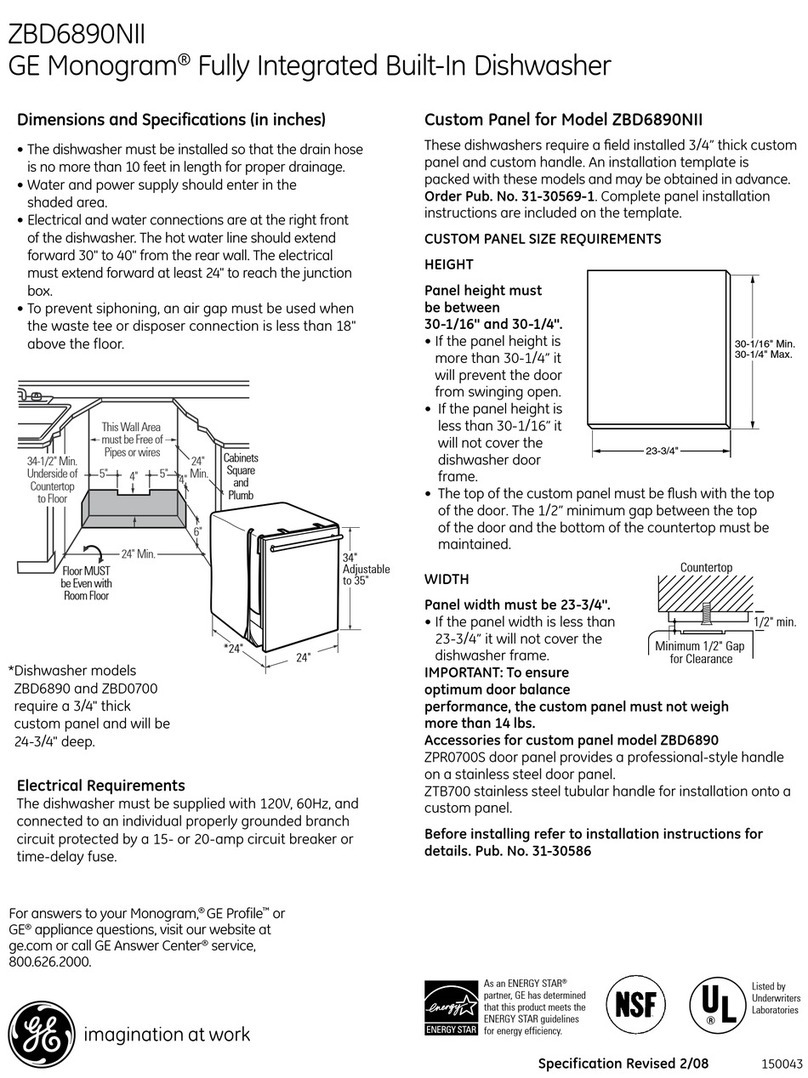
GE
GE Monogram ZBD6890NII User guide

GE
GE Electronic Dishwasher User manual
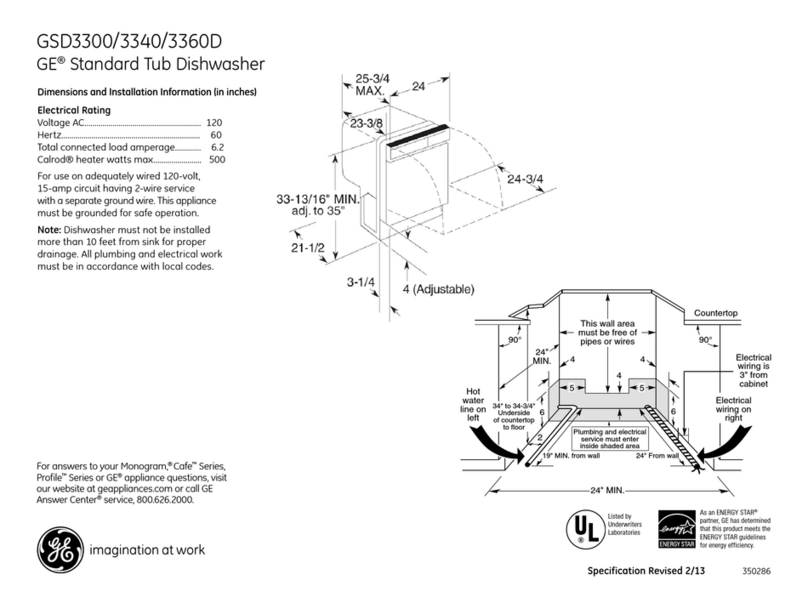
GE
GE GSD3300 Manual
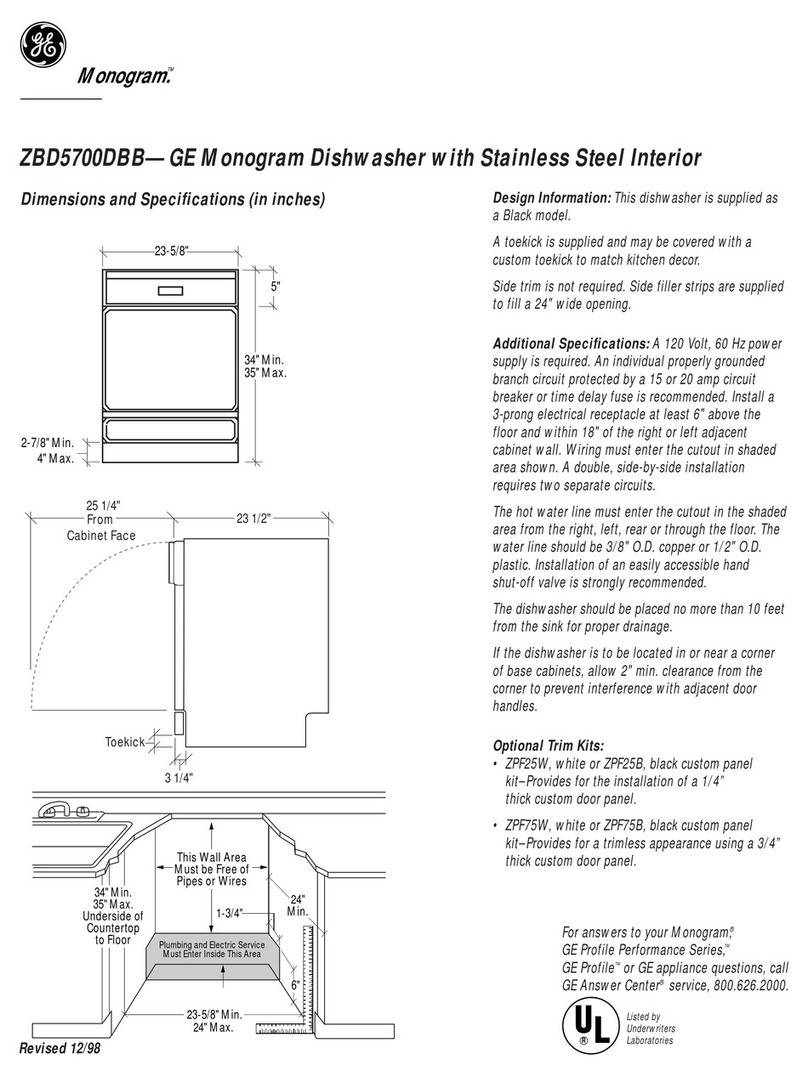
GE
GE Monogram ZBD5700DBB User instructions
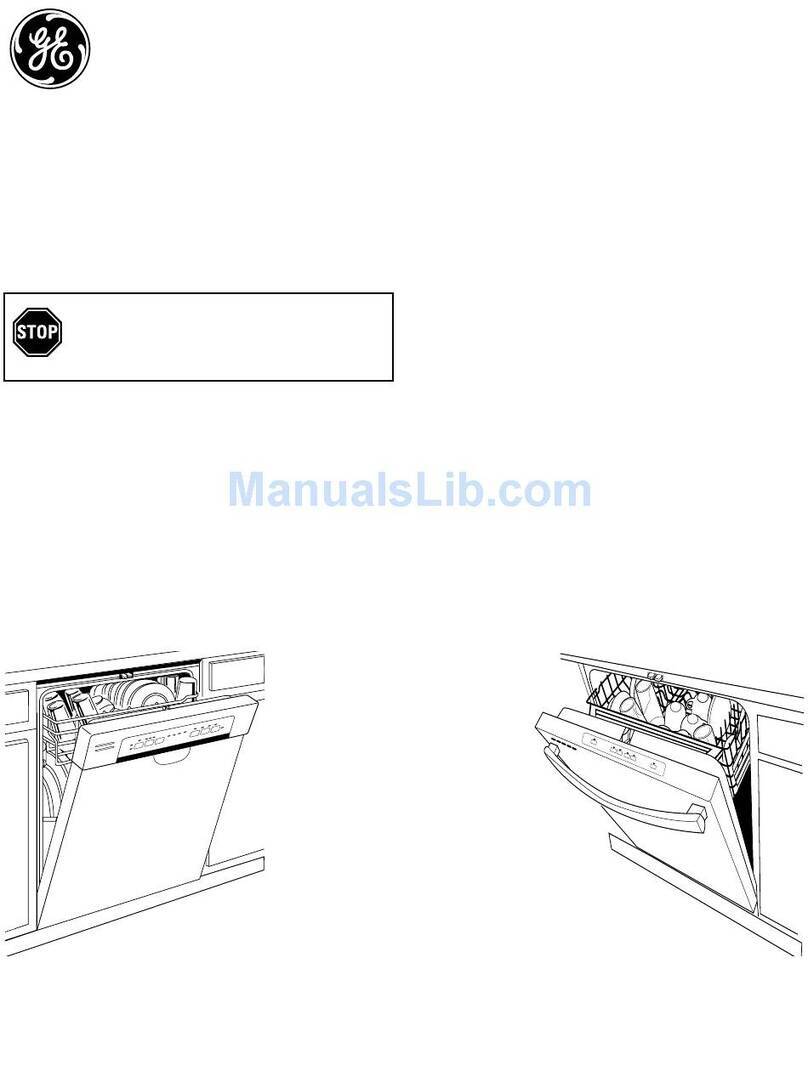
GE
GE GDF510PSDSS User manual

GE
GE GSM1800F02BB User manual

GE
GE GDF610PGJ Manual

GE
GE GSD4300 Series User manual

GE
GE GSD630 User manual
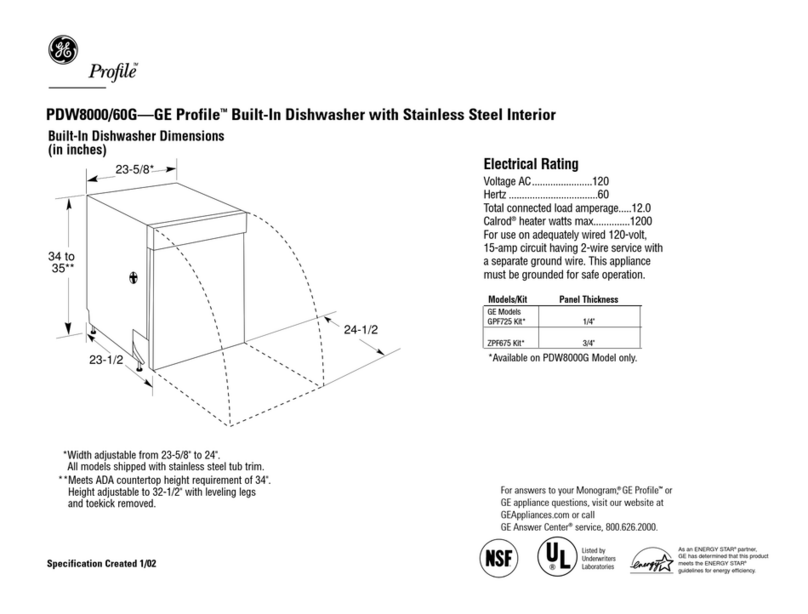
GE
GE GE Profile PDW8000G User instructions
